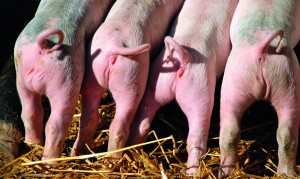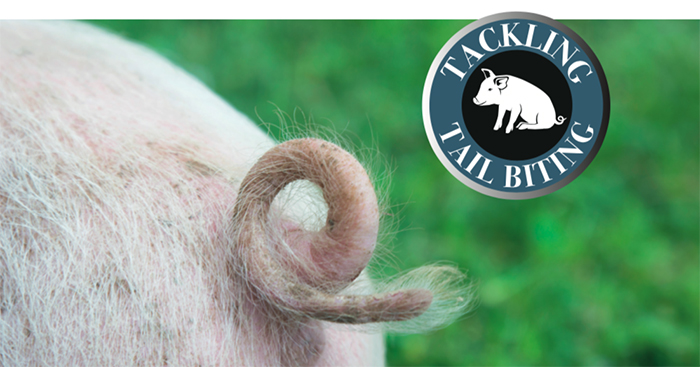In the latest in our series of features on tail biting, AHDB outlines the steps to take once you’ve identified the warning signs on farm.
If pig producers are seeing early warning signs of tail biting, the next step is to carry out a thorough assessment of the risks of a tail biting outbreak occuring. It’s the second part of the four-stage process to help tackle tail biting – record, assess, act and review. The approach is one based on a clear methodology and common sense, to help producers take a fresh look at how to tackle the problem and hopefully move towards a lasting reduction in incidence.
Keeping a record of pigs’ behaviour and any early signs of tail biting, as discussed in last month’s Pig World, is a good starting point for assessing risks, as producers should consider, firstly, the early warning signs they see and, secondly, health, environmental and management factors on farm that may be potential risks.
AHDB’s webHAT (online husbandry advice tool) has a risk assessment section in which producers can look at the information and guidance on a range of different tail biting risk factors and select the ones present on their farm. In conjunction with your vet, this then generates a specific risk report for that farm and allows you to add in additional factors specific to it (if you have had an outbreak of diarrhoea, for example).
AHDB senior knowledge exchange manager Kate Mellor said: “Producers can complete their own risk assessment, but there is additional value from having the vet alongside them as they can give a different perspective and discuss the report and possible next steps.
“The webHAT report lists the risks in order, starting at the top with those which have been scientifically shown to have the strongest level of association with tail biting. There are some risks which appear at the end of the report which could not be fully assessed during the ‘husbandry advice tool’ development project, so they couldn’t be ranked. However, vets and scientific literature still suggest they are important, so don’t ignore those.”
It may not always be appropriate to work on the highest risk factor – shown at the top of the report – first, or to focus on that one alone said Mrs Mellor. “For example, high numbers of hours of sunshine or cold pen temperature carry a higher risk of tail biting compared to other risk factors, but it will depend on what time of year it is as to how much effect they are having.

“Be careful not to always work on the top risk first at the expense of others. Also, the greatest risk may need larger or longer term changes to tackle it, so consider quicker, simpler changes as well to help reduce risk – to some extent, at least – as soon as possible.”
The early warning signs to consider in the risk assessment include tails being tucked under, restless or agitated pigs, ear or body lesions and pigs chewing
or mouthing other pigs. The range of environmental and management factors that could pose a risk are wide ranging and may be related to weather, health programme, tail lengths, enrichment, feed or water provision, genetics, pen layout, equipment and hygiene.
Taking one example, tail biting is more likely in pens where pigs have a mix of tail lengths – either a mix of docked and undocked tails, or a mix of docked tail lengths. A mix of tail lengths is likely to stimulate the interest of pigs because of the novelty of the different lengths and movements of the tail.
Another example is the presence of fouled drinkers which could reduce pigs’ water uptake and could increase competition for preferred drinkers. Presence of fouled drinkers may also indicate problems in daily care and management of the animals.
In the area of health management, a third example is not using a PCV2 vaccine where PCV2 has been identified by the vet as an issue. Significantly lower levels of tail biting have been found on units following introduction of PCV2 vaccines.
The vaccination against porcine respiratory viruses and improving health in general may be beneficial in improving pigs’ tolerance to other stressors in the environment. Producers should speak to their vet if they are concerned that this is a contributing factor.
The risk report also offers some suggestions for what action to take and when, to help reduce different risk factors. Providing environmental enrichment is one course of action which may be suggested as a solution for some factors and, if it is, AHDB’s guide to ‘Environmental enrichment for pigs’, provides practical guidance for all types of production system.
Enrichment is, of course, also a legal requirement but additional enrichment on its own does not always reduce the risk of tail biting. The management areas where actions may be suggested also include: ventilation, cooling measures, keeping pigs warmer via solid gates or covered lying areas, regular cleaning of drinkers and training of stockpeople.
Vet Susan Walpole, the chair of Pig Veterinary Society’s welfare group, said: “Pig welfare is a vet’s top priority and AHDB’s tool is an excellent opportunity for producers and vets to help identify areas that can be looked at to reduce tail biting on farm. Tail biting is such a complex issue and there are many factors affecting when and why it occurs.
“Recording outbreaks is key to providing some insight into why it may be happening and early identification may allow an outbreak to be minimised. The difficulty is knowing what to do when an outbreak is in full swing.
“We need more information about effective methods to get control of an outbreak. However, the WebHAT will certainly assist producers in taking a pro-active approach to tackling the tail biting issue. The health of the pigs is often a factor in tail biting outbreaks and should be included in any assessment.”
As well as the tools and guidance provided on the online tool to help with the process of recording, assessment, action and review, two new Strategic Farms aiming to reduce tail biting will be following the process. AHDB will share, anonymously, how the they are getting on over the course of the coming year.
More information:
Visit: webhat.ahdb.org.uk
Contact your knowledge exchange manager: pork.ahdb.org.uk/meet-the-team/knowledge-exchange-managers
Order free ‘early warning signs’ poster by emailing details to comms@ahdb.org.uk




